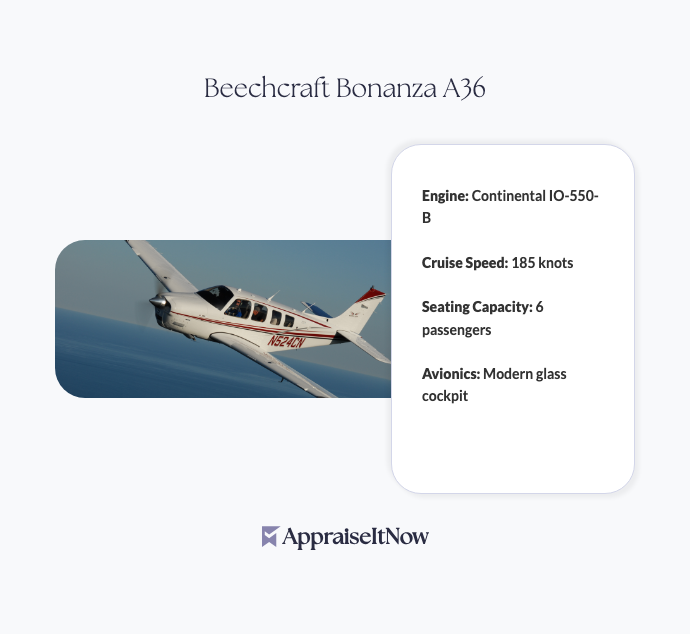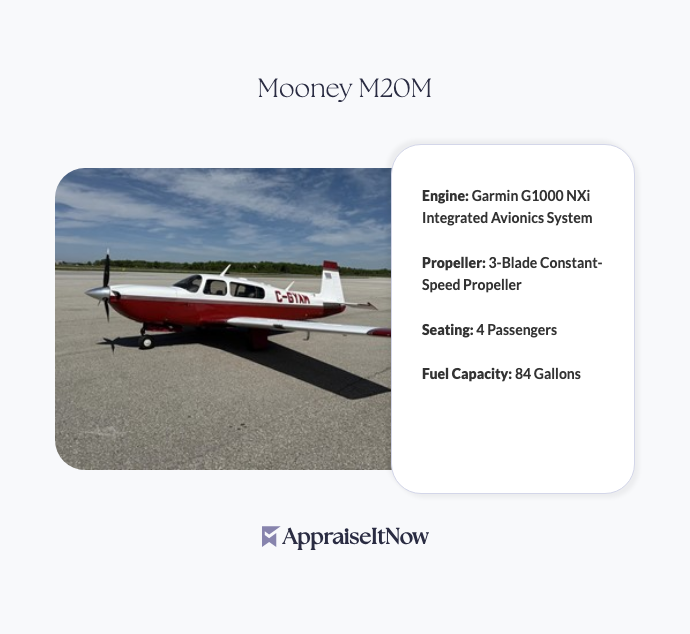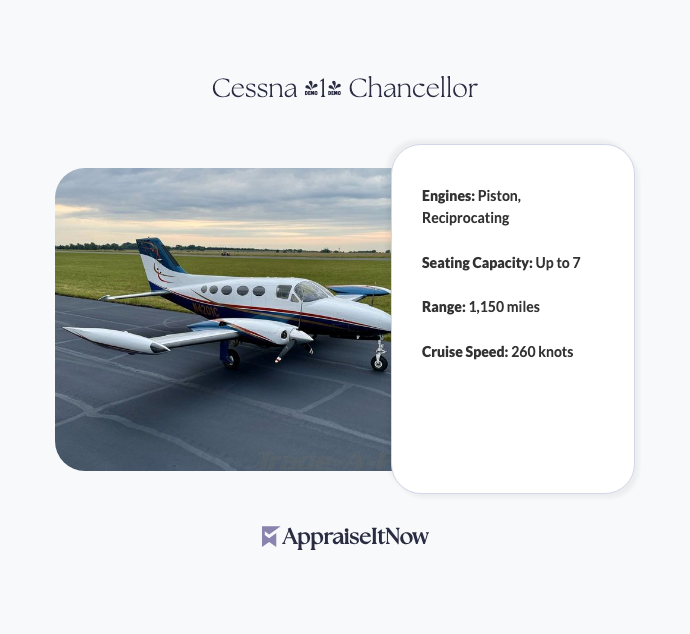<h1>How to Get Your Beechcraft Bonanza A36 Appraised</h1>
<p>The Beechcraft Bonanza A36 remains one of the most sought-after single-engine aircraft in the general aviation market, commanding values between <strong>$50,000 and $80,000</strong> depending on condition, maintenance history, and avionics configuration. Whether you're buying, selling, or verifying your aircraft's worth for insurance purposes, understanding the appraisal process ensures you get an accurate, defensible valuation. If you're considering selling your aircraft or need documentation for financing or insurance, a professional appraisal becomes essential.</p>
<h2>Understanding Your Bonanza A36's Market Position</h2>
<p>The Bonanza A36 occupies a unique position in aviation due to its exceptional reputation for speed, range, and reliability. First introduced in 1947, this iconic aircraft has earned its place as a favorite among private pilots and aviation enthusiasts worldwide. Your A36 features a Continental IO-550-B engine delivering impressive cruising speeds up to 185 knots, paired with a spacious cabin accommodating six passengers comfortably.</p>
<p>The aircraft's robust metal construction and advanced avionics suite—including modern glass cockpit displays—distinguish it from competing models in its market segment. This combination of performance, capacity, and proven reliability drives consistent demand among both individual owners and commercial operators. Understanding what makes your specific Bonanza valuable requires examining both its technical specifications and its condition relative to comparable aircraft in the current market.</p>
<h2>What Determines Your Bonanza A36's Appraisal Value</h2>
<p>Professional appraisers evaluating your A36 examine multiple interconnected factors to establish fair market value. The aircraft's age and total flight hours form the foundation of any valuation, as these directly impact remaining service life and future maintenance costs. However, condition tells a more nuanced story than age alone, particularly when evaluating avionics systems and engine health.</p>
<p>Your Bonanza's maintenance history significantly influences appraiser assessments. Aircraft with complete logbooks documenting regular inspections, engine overhauls, and component replacements typically command premium valuations compared to those with gaps in documentation. An engine overhaul, one of the most expensive maintenance items on any aircraft, can add substantial value when recent and properly documented. Modifications also play a critical role—tip tanks for extended range, modern glass cockpit upgrades from steam gauges, or improved interior appointments can increase value considerably or, if poorly executed, potentially decrease it.</p>
<p>The avionics package deserves particular attention during appraisal. A well-equipped A36 with modern glass cockpit displays, autopilot systems, and current navigational equipment attracts buyers willing to pay premium prices, whereas older steam-gauge instrumentation may necessitate costly upgrades for buyers seeking modern capabilities. Geographic location and local market conditions also influence final valuations, as aircraft in regions with active aviation communities or favorable weather patterns for year-round flying often sell at higher prices than those in limited-use markets.</p>
<h2>Comparing Your Aircraft to Market Comps</h2>
<p>Establishing your Bonanza A36's value requires comparing it against similar aircraft recently sold or currently listed. Professional appraisers subscribe to aviation databases tracking comparable sales, reviewing factors like model year, total airframe hours, engine status, and equipment specifications. This comparative market analysis forms the backbone of any credible aircraft appraisal, similar to how <a href="/blog/what-is-an-automobile-appraisal">automobile appraisals</a> use comparable sales data to establish fair market values.</p>
<p>The challenge lies in finding truly comparable aircraft—two A36s with identical airframe hours may differ dramatically in value based on avionics, interior condition, and maintenance records. An aircraft with 3,000 total hours but recent engine work and modern glass cockpit equipment often appraises higher than another with 2,800 hours featuring older instrumentation and deferred maintenance. Professional appraisers understand these nuances and position your aircraft appropriately within the current market, whether that's at the lower end of the $50,000 range or commanding premium pricing near $80,000.</p>
<h2>Modifications and Upgrades That Impact Value</h2>
<p>Your Bonanza A36 may include various modifications enhancing performance, range, or mission capability. Tip tanks extending fuel capacity represent one of the most valuable upgrades, directly increasing range capability and expanding the aircraft's utility. Similarly, avionics upgrades from traditional instrumentation to integrated glass cockpit systems substantially increase modern buyer appeal and market value, particularly if the systems are well-maintained and current with software updates.</p>
<p>Interior upgrades including leather seats, modern soundproofing, or refreshed cabin appointments add perceived value and improve the ownership experience. However, appraisers evaluate modifications conservatively—poorly executed or questionable alterations may not recoup their full cost. Additionally, aircraft modifications must comply with FAA regulations and be properly documented through maintenance records and STC (Supplemental Type Certificate) approvals. A modification lacking proper documentation can actually reduce value by creating future regulatory and resale complications, whereas properly certified upgrades enhance both safety and market appeal.</p>
<p>Engine overhauls represent perhaps the most significant value driver among modifications. If your A36's Continental IO-550-B has undergone a recent overhaul, expect appraiser recognition of this substantial investment. A fresh engine overhaul can add $15,000 to $25,000 to your aircraft's valuation, reflecting both the cost of the work and the extended service life it provides to the next owner.</p>
<div class="callout tip"><p><strong>Valuation Insight</strong></p>
<p>Recent avionics upgrades and engine work should always be thoroughly documented with invoices and maintenance logs—professional appraisers verify these claims before adjusting valuations upward.</p></div>
<h2>Documentation Requirements for Professional Appraisal</h2>
<p>Preparing comprehensive documentation streamlines your aircraft appraisal and often results in higher, better-supported valuations. Start by gathering your aircraft's logbooks covering the entire operational history, along with records documenting all maintenance, inspections, and component replacements. The FAA requires complete logbook maintenance for all aircraft, and gaps in documentation raise questions about maintenance compliance that negatively impact appraisals.</p>
<p>Your appraisal process will require high-quality photographs documenting exterior condition, interior appointments, instrument panels, engine compartment, and any visible damage or wear. Professional appraisers often take these images themselves during in-person inspections, but having your own documentation ready demonstrates diligence and transparency. Gather all modification paperwork including STCs for any non-standard equipment, engine overhaul receipts with shop documentation, and avionics upgrade records showing compliance with modern standards.</p>
<p>Additionally, compile your aircraft's title documentation, registration records, and any previous appraisals if available. If you've had the Bonanza inspected recently through a pre-purchase inspection or annual inspection, include the inspector's reports as these provide third-party assessment of condition. When seeking appraisals for <a href="/blog/using-automobile-appraisals-for-insurance-purposes">insurance purposes</a>, insurers often require detailed condition documentation and recent photos—having these prepared saves time and supports accurate coverage limits.</p>
<h2>Remote Appraisals vs. In-Person Inspections</h2>
<p>One common question aircraft owners ask involves whether remote appraisals suffice or if in-person inspections are necessary. While photography and detailed descriptions provide valuable information for preliminary assessments, professional appraisers typically recommend in-person inspections for aircraft valuations, particularly when significant value rests on condition assessments and technical specifications.</p>
<p>Remote or photo-based appraisals work best when you've recently had the aircraft professionally inspected and possess comprehensive documentation. AppraiseItNow offers flexible appraisal options accommodating aircraft owners' varied situations—some clients can provide extensive photos and maintenance records enabling reliable remote valuations, while others benefit from direct inspection when condition verification becomes critical. For high-value aircraft near the upper end of the $80,000 range or those with significant modifications, in-person inspection provides the confidence and documentation lenders, insurers, and buyers expect.</p>
<div class="callout note"><p><strong>Remote Appraisal Consideration</strong></p>
<p>AppraiseItNow coordinates with credentialed aviation appraisers across the U.S., meaning your aircraft's location won't prevent you from accessing expert valuations suited to your specific circumstances.</p></div>
<h2>Using Your Appraisal for Different Purposes</h2>
<p>A certified Beechcraft Bonanza A36 appraisal serves multiple critical functions beyond simple curiosity. When purchasing with financing, lenders typically require independent appraisals to establish loan-to-value ratios, ensuring the aircraft's appraised value supports the financing amount. This protects both the lender and you as the buyer, preventing underwater loan situations where the aircraft's market value falls below outstanding debt.</p>
<p>Insurance providers rely heavily on professional appraisals when establishing coverage limits and determining premiums. An accurate appraisal for insurance purposes ensures you maintain adequate coverage reflecting your aircraft's true replacement cost. Underinsurance leaves you vulnerable to inadequate claims settlements, while overinsurance results in unnecessarily high premiums. An USPAP-compliant appraisal from credentialed experts provides insurance companies the documentation they require, streamlining coverage establishment and future claims handling.</p>
<p>For tax purposes, particularly if you're claiming depreciation deductions or need valuations for estate planning, IRS regulations often require independent professional appraisals. Similarly, when aircraft ownership involves business assets, divorce settlements, or bankruptcy proceedings, courts and professionals rely on certified appraisals to establish fair market value. Professional appraisals from credentialed appraisers provide the documentation weight that informal estimates or blue-book values cannot match.</p>
<h2>Understanding Appraisal Frequency and Updates</h2>
<p>The question of how often you should update your Bonanza A36 appraisal depends on your circumstances. For insurance purposes, updating appraisals every three to five years typically captures significant market changes while avoiding unnecessary reassessment costs. If you've made substantial modifications, completed major maintenance, or your aircraft's condition has changed notably, obtaining a fresh appraisal sooner ensures your insurance reflects current reality.</p>
<p>If you're actively considering selling, obtaining a current appraisal within the previous year provides the strongest foundation for establishing realistic asking prices. Market conditions for general aviation aircraft can shift based on fuel prices, economic conditions, and regulatory changes affecting operational costs. Financing situations also call for current appraisals—most lenders require valuations dated within 90 days of loan application, reflecting current market conditions rather than historical valuations.</p>
<p>Professional appraisers can sometimes provide updated valuations based on market analysis without full re-inspection if aircraft condition hasn't changed significantly, though you'll want to clarify this with your appraiser. The investment in periodic reappraisals protects you financially whether buying, selling, insuring, or planning your aviation asset's future.</p>
<h2>Selecting the Right Appraiser for Your Aircraft</h2>
<p>Choosing an aircraft appraiser requires evaluating credentials and expertise specific to general aviation. Look for appraisers holding credentials from recognized organizations like AAA, ISA, ASA, CAGA, or AMEA, indicating they've met professional standards and ethical requirements. These credentialed experts understand aviation-specific valuation challenges and maintain current knowledge of market trends affecting aircraft values.</p>
<p>When evaluating potential appraisers, ask about their specific experience with Beechcraft Bonanza A36 valuations. Appraisers with direct familiarity with your aircraft model understand model-specific factors affecting value—they know which upgrades command premium pricing and which modifications represent questionable investments. They also understand regional market variations and how location influences A36 valuations.</p>
<p>AppraiseItNow connects you with qualified aviation appraisers throughout the U.S., each offering the credentials, experience, and professional standards you need. Our platform streamlines the process, matching your aircraft to appropriate expertise and managing the appraisal timeline efficiently. Whether you need a straightforward valuation or a complex assessment involving significant modifications, working with credentialed professionals ensures your appraisal withstands scrutiny from lenders, insurers, and legal representatives.</p>
<div class="callout tip"><p><strong>Appraiser Selection Tip</strong></p>
<p>Ask potential appraisers for references from previous clients and inquire about their USPAP compliance—this commitment to professional standards ensures your appraisal meets legal and professional requirements across all purposes.</p></div>
<h2>The Aircraft Appraisal Investment</h2>
<p>Professional appraisal fees for Beechcraft Bonanza A36 valuations typically range from $500 to $2,000 depending on complexity, inspection requirements, and reporting depth. While this represents a genuine investment, consider it insurance protecting far larger financial interests. A $1,000 appraisal ensuring accurate valuation on a $65,000 aircraft represents modest cost for confidence and documentation that prevents costly mistakes.</p>
<p>For similar valuation insights across other <a href="/types/aircraft">aircraft types</a>, AppraiseitNow provides expertise spanning <a href="/types/private-jet">private jets</a>, <a href="/types/helicopter">helicopters</a>, and other <a href="/types/commercial-aircraft">commercial aircraft</a>. Each aircraft category requires specialized knowledge, and our network includes appraisers with appropriate expertise regardless of your aviation asset type.</p>
<div class="callout note"><p><strong>Key Takeaway</strong></p>
<p>A certified Beechcraft Bonanza A36 appraisal provides the professional documentation and market analysis you need for buying, selling, financing, or insuring your aircraft with confidence. Whether you're seeking current market value, documenting condition for insurance purposes, or establishing fair market value for tax or legal matters, professional appraisers deliver the credible valuations that protect your aviation investment and satisfy lenders, insurers, and legal representatives' requirements.</p></div>







.avif)







